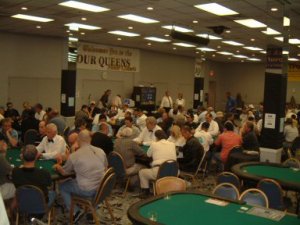Every player in a tournament pays the same entry fee and receives the same number of chips in exchange. Thus if it is a $30 tournament every player might receive 1000 chips in exchange for their $30. In fact the entry fee is more likely to be $30+$3, where '+$3' represents the registration fee, a $3 charge for the cardroom.
There are two main types of tournaments: freeze-out and re-buy events.
In a freeze-out you only receive your initial chips, 1000 in our example, and there is no option to buy any more. Once you lose these chips you are completely eliminated from the competition.
In a re-buy event, however, players who have lost their chips are allowed to re-enter for a certain amount of time, usually one hour or 90 minutes. They can choose to purchase a replacement 1000 chips for an additional $30 and keep playing. Even if they lose these chips as well, they can still re-buy, as long as they are still in the designated re-buy period.
At the end of the re-buy period every player remaining in the competition is usually entitled to purchase one add-on, i.e. to buy an additional 1000 chips for $30 in our example. Once the re-buy period is over the tournament reverts to a freeze-out format. Anyone who loses their chips is eliminated and cannot buy any more chips.

As players are eliminated in the freeze-out period tables are consolidated in such a way that the number of players on each table is balanced. Eventually enough players will have been knocked out to consolidate the remaining nine or ten players onto a single table, the final table.
The winner is the player who ultimately ends up with all the chips in play. However, usually the prizes are structured in such a way that several players receive a prize. For example, first place might be 50% of the prize fund, second place 30% and third place 20%. In large tournaments with 40 or more runners often everyone at the final table will receive a prize, and the winner's share of the prize fund may go down to 30-35%.
The other key difference between tournaments and cash games relates to the blinds. In a cash game the blind levels do not change during a game. However, in tournaments the blinds are always raised periodically in order to speed up the action. For example, the blinds might be 25-50 for the first 20 minutes, 50-100 for the next 20 minutes, 75-150 for the next 20 minutes, then 100-200, then 150-300, then 200-300 etc. This blind structure accelerates the game because there is always pressure on the low stacks to take a stand or risk simply being 'blinded away'.
